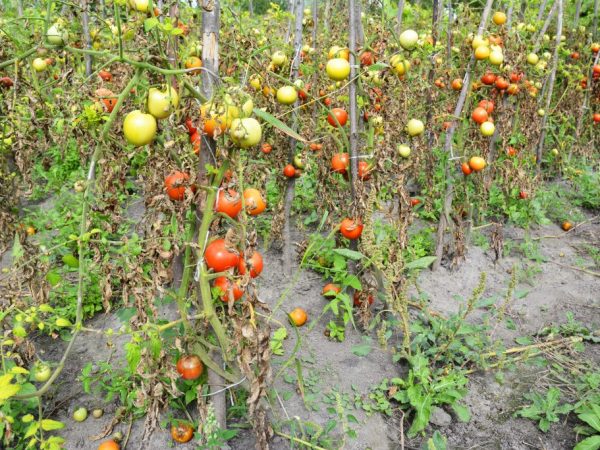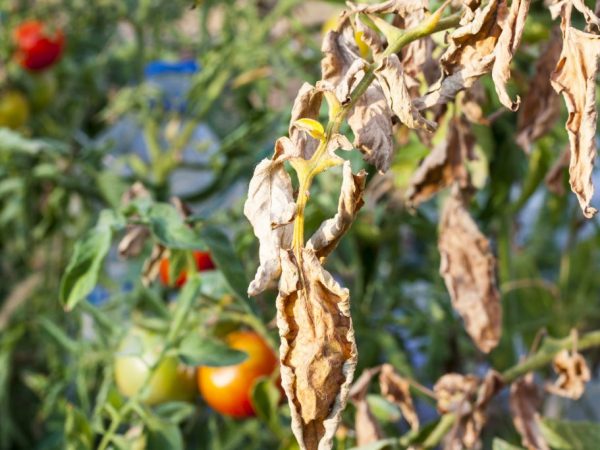How to Treat Tobacco Mosaic Virus on Tomatoes
One of the most common diseases, the tobacco mosaic virus on tomatoes destroys the seeds, seedlings and bushes of the plant. The disease is caused by a virus with the consonant name of Nicotine. In favorable conditions, the infection spreads quickly and can destroy all future crops.

Tobacco Mosaic Virus on Tomatoes
Seedling plants, which have not yet developed sufficiently strong defense mechanisms, suffer most from tobacco mosaic. With growing seedlings, the gardener often conducts various agrotechnical measures, spreading the virus to seedlings of other crops.
General characteristics of the disease
Tobacco mosaic of tomatoes, the treatment of which is carried out when the first symptoms appear, is familiar to every experienced gardener. In most cases, the virus appears in the greenhouse while the seedlings are growing. High humidity creates all the necessary conditions for the rapid spread of the virus. Suffer from the disease can:
- a tomato;
- spinach;
- cucumbers;
- cabbage.
Every carrier of the virus is a threat to neighboring crops. The infected plant withers quickly and changes the color of foliage and stems.
The root system is the last to suffer from the virus. Characteristic stains form on tomatoes, which should be dealt with with homemade (natural) or purchased products (substances with active bacteria that can protect the culture).
The root cause of the disease and the sources of the virus
Tobacco mosaic on healthy tomatoes occurs in greenhouse conditions or on an open land plot, if the gardener does not follow the rules for conducting agrotechnical measures: old equipment, unfertilized soil, improper plant care. The main reasons for the appearance of the virus on tomatoes:
- too dense planting;
- poor ventilation (on an open land plot, drafts or insufficient air ventilation);
- high humidity.
In a greenhouse or garden, improper temperature conditions or too high humidity will lead to infection of plants with a virus. Tobacco mosaic is defined by a number of symptoms that will be a clue to the novice gardener. If a virus has started on the tomatoes, characteristic yellow dry spots appear on the green leaves and stems. The green part of the tomatoes becomes like a mosaic with dark and light areas.
The sources of the disease are the remains of other plants, soil or infected seedlings. Seeds can infect neighboring crops. Contact method of transmission of the virus is the most common and dangerous. Insects quickly spread the infection to all plants in the greenhouse or garden.
Symptoms of the disease
Over time, the virus completely destroys the foliage: the deformation of the border leads to the drying of the stems and leaves. With an advanced disease, growths appear on the foliage in the form of hard lumps.
The infection affects the condition of the fruits: tomatoes ripen for a long time and significantly decrease in size. Gradually, the disease spreads to neighboring crops, and whole rows of planted tomatoes dry out.
Treatment of the disease

The disease needs to be treated as quickly as possible.
Tomato mosaic tobacco can contribute to other infections. Mixed diseases lead to a tomato strip, which leads to a weakening of the stems (the bushes break and dry out).
The fight against the virus begins at the first appearance of yellowness on the foliage. For a good harvest of tomatoes, timely prevention and treatment of leaves, stems and fruits from a viral infection is necessary.
Tobacco mosaic treatment
The treatment of mosaic on tomatoes begins with the treatment of diseased crops.
For these purposes, a home-made solution is prepared: 100 g of micronutrient fertilizers are added to a liter of milk whey. The prepared liquid gently processes the leaves on the tomatoes (you must go through each leaf) and the stems. For better handling, use a conventional spray bottle.
Treatment of plants from a viral disease is not limited only to the treatment of the bush, but also to cleaning the soil. The soil that is infected with the virus is unsuitable for further planting of seedlings. The top layers of the soil are removed completely (up to 15 cm). The new embankment is washed with a concentrated solution of potassium permanganate (proportion with water 1: 1) and dried. The renewed soil is fertilized with nitrogen-containing substances and milk whey.
Prophylaxis
Prevention of tomato tobacco mosaic will help avoid long-term treatment of the crop and prevent crop destruction. Preventive work includes processing an already healthy bush, seedlings and preparing seeds that are planted in fertilized soil.
Tomato virus infection spreads rapidly in greenhouses and in humid environments. Constant ventilation of covered rooms and removal of moisture accumulated on the walls will eliminate the threat of the virus. The soil for planting seeds and finished seedlings is treated with a weak solution of potassium permanganate. Before planting, the soil is frozen and moistened.
Seed treatment
Tobacco mosaic threatens seeds, which can carry infection for several weeks. To enhance seed protection, prophylaxis is carried out before planting seedlings in the greenhouse. Before sowing, all seeds are soaked in a solution of potassium permanganate (1% solution) or for about 2 hours in the "Fitosporin" preparation. After processing, the seeds are planted in moist soil.
Seedlings with the first signs of disease are removed from the greenhouse and burned. After processing the soil, all equipment is washed and disinfected. Seedling boxes and pots are processed for 4 consecutive days. For these purposes, a 5% solution of potassium manganese is used.
Disease prevention on open land plots
General disease prevention will protect mature bushes until harvest. The planted seedlings must be vaccinated against the virus (vaccinated), 20% hydrochloric acid is used to disinfect seeds, seedlings and bushes.
The upper layers of the soil in an open area are fertilized with mineral complexes that help get rid of pests (carriers of the virus). The beds between the bushes are well weeded at least once a week so that other plants do not cause the destruction of the future harvest.
Conclusion
Infection occurs due to a number of avoidable factors. The virus spreads in poorly cleaned greenhouses, where humidity and temperature conditions are not observed. Virus-resistant seeds treated prior to planting.
Tomatoes protect themselves from insects, and during the rainy season, the bushes should be fertilized more and watering should be reduced. Tobacco mosaic in domestic tomatoes heals well immediately after infection, but spreads rapidly. Comprehensive measures will help protect the culture from a common disease.


